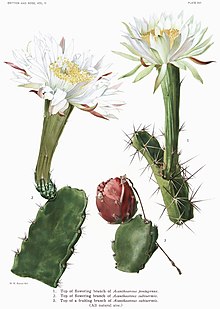Acanthocereus
| Acanthocereus | |
|---|---|
 |
|
| A. tetragonus flower (left), A. subinermis flower and fruit (right) | |
| Scientific classification | |
| Kingdom: | Plantae |
| (unranked): | Angiosperms |
| (unranked): | Eudicots |
| (unranked): | Core eudicots |
| Order: | Caryophyllales |
| Family: | Cactaceae |
| Subfamily: | Cactoideae |
| Tribe: | Pachycereeae |
| Genus: |
Acanthocereus (Engelm. ex A.Berger) Britton & Rose |
| Species | |
|
Acanthocereus baxaniensis |
|
Acanthocereus baxaniensis
Acanthocereus colombianus
Acanthocereus horridus
Acanthocereus occidentalis
Acanthocereus subinermis
Acanthocereus tetragonus
Acanthocereus is a genus of cacti. Its species take the form of shrubs with arching or climbing stems up to several meters in height. The generic name is derived from the Greek word άκανθα (acantha), meaning spine, and the Latin word cereus, meaning candle.
The six species occur in the tropical Americas from the southern tip of Florida to Colombia, including islands of the Caribbean.
Stems have 3 to 5 ribs, typically thin, with stout spines. The pretty white funnel-shaped flowers are night-opening, 12–25 cm (4.7–9.8 in) long and 6–12 cm (2.4–4.7 in) in diameter.
Acanthocereus tetragonus, commonly known as Barbed-wire Cactus, Chaco, Nun-tsusuy, or Órgano, is the most widespread of the genus and the largest, reaching 2–7 m (6.6–23.0 ft) tall.
The name was first used by George Engelmann in 1863, although he did not describe its characters, leaving it to Alwin Berger in 1905 to define it as a subsection of Cereus. In 1909, Nathaniel Britton and Joseph Nelson Rose elevated Acanthocereus to a genus.
The genera Dendrocereus Britton & Rose and Monvillea Britton & Rose have been brought into synonymy.
...
Wikipedia
